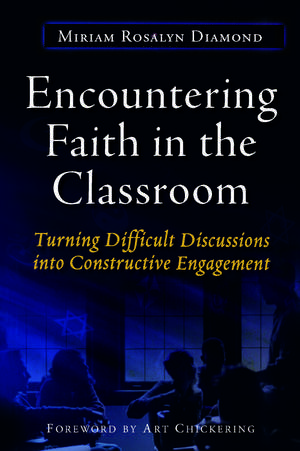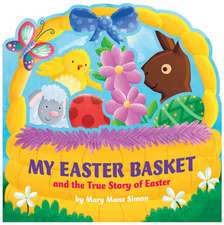Encountering Faith in the Classroom: Turning Difficult Discussions into Constructive Engagement
Editat de Miriam R. Diamonden Limba Engleză Paperback – 10 apr 2008
Preț: 235.58 lei
Nou
Puncte Express: 353
Preț estimativ în valută:
45.08€ • 49.12$ • 37.98£
45.08€ • 49.12$ • 37.98£
Carte disponibilă
Livrare economică 02-16 aprilie
Preluare comenzi: 021 569.72.76
Specificații
ISBN-13: 9781579222376
ISBN-10: 1579222374
Pagini: 242
Dimensiuni: 152 x 229 x 15 mm
Greutate: 0.4 kg
Ediția:1
Editura: Taylor & Francis
Colecția Routledge
Locul publicării:Oxford, United Kingdom
ISBN-10: 1579222374
Pagini: 242
Dimensiuni: 152 x 229 x 15 mm
Greutate: 0.4 kg
Ediția:1
Editura: Taylor & Francis
Colecția Routledge
Locul publicării:Oxford, United Kingdom
Public țintă
PostgraduateCuprins
Acknowledgements Foreword—Art Chickering Introduction. Faith in Learning. An Overview—Miriam Rosalyn Diamond and Christina Copre PART ONE—SOCIETY, LEARNING, AND RELIGION 1. Faith and Reason. Higher Education’s Opportunities and Challenges—Nancy L. Thomas and Ann Marie B. Bahr Appendix. Wingspread Declaration on Religion and Public Life PART TWO—STUDENT AND FACULTY PERSPECTIVES 2. Undergraduate Perspectives About Religion in Higher Education—Lois Calian Trautvetter 3. Faith in Graduate Education. Perspectives of Students and Faculty in Student Affairs Preparation Programs—Judy L. Rogers and Patrick G. Love PART THREE—CONSIDERATIONS 4. Blinking in the Sunlight. Exploring the Fundamentalist Perspective. Peggy Catron 5. What I Think I Believe. Using the CHANGE Method to Resolve Cognitive Dissonance—Tamara H. Rosier 6. Bringing Faith and Spirituality into the Classroom. An African American Perspective—Mark S. Giles, Odelet Nance and Noelle Witherspoon 7. Religion in the Classroom. Legal Issues—Barbara A. Lee PART FOUR—DISCIPLINARY APPROACHES 8. Exploring Religion and Spirituality through Academic Service-Learning—Kent Koth 9. Philosophy and Religious Disagreements in the College Classroom—Dona Warren 10. When Faith and Science Collide—Mano Singham 11. Teaching Secular Bible Reading to Religiously Committed Students—Roger G. Baker 12. The Role of Religion and Spirituality in the Law School Classroom—David Hall 13. Teaching About Religious and Spiritual Pluralism in a Professional Education Course—Robert J. Nash and Sue M. Baskette Afterword—Miriam Rosalyn Diamond About the Authors Index
Notă biografică
Miriam R. Diamond is a faculty developer and coordinator of the Society for Values in Higher Education's Religion and Public Life Project. She was formerly Associate Director for Faculty Programs at Northwestern University's Searle Center for Teaching Excellence She is co-author of Chalk Talk: E-Advice from Jonas Chalk, Legendary College Teacher. Miriam has researched, published, consulted, and led workshops internationally on ethical development, educational outcomes of creative interactive lesson plans, using technology to create learning communities, and holistic approaches to teaching and learning. She teaches courses in education, the psychology of adult development, ethics, and religious studies. Art Chickering
Recenzii
"Among the many volumes now available on religion and spirituality in higher education, this one stands out for moving beyond basic description and broad prescription to a discussion of actual pedagogical practice... Encountering Faith in the Classroom is an important book for professors of theology and religious studies to read."
Teaching Theology and Religion
www.unc.edu/ddi/blog/2008/07/faith-in-classroom.html
Click on above link for review in Peter M. Wright's "Teaching for Inclusion" blog
"Encountering Faith in the Classroom: Turning difficult discussions into constructive engagement presents a theoretical justification as well as practical tools for intentionally introducing and thoughtfully managing classroom exploration of religious and spiritual values that are an inherent part of the makeup of college and university students. In the foreword, Art Chickering stresses that it is in the classroom that challenges of religion and spiritual diversity must be addressed. Diamond’s book situates educators to better develop their awareness and integration of this important area of student development into the classroom. Though largely targeted for classroom settings, the ability of faculty as well as student affairs professionals to engage in difficult yet meaningful dialogue in the classroom as well as in mentoring and advisory roles is clearly relevant as an important component of holistic student development.
Many who argue against inclusion of religion and spirituality in higher education do so from a concern that one religion is promoted over another. Clearly, as is noted above, this is not the case among educators included in this text. The value as addressed by all of the authors for integration of religion and spiritual concepts lies in goals of developing critical thinking skills, a stronger knowledge base of religions and belief systems held by our students, and a resulting improved ability to understand one another which can lead to a stronger, more inclusive democracy.
In this book, religion and spirituality are not explored in terms of coercing or changing one’s belief system nor is this book an effort to espouse which, if any, religion is correct. Instead, it is about learning and better understanding one’s own religion or lack thereof, as well as the religious convictions of others. Further, it is about being able to have dialogue around these topics which are great influences on who we are."
Education Review: A Journal of Book Reviews
"Researchers in education and teachers in a number of disciplines suggest various approaches for de-problematizing issues relating to religion in secular classrooms. Their topics include faith in graduate education, using the CHANGE method to resolve cognitive dissonance, when faith and science collide, and law school."
Book News Inc.
"Religion is a touchy subject -- one wrong word can imply a deep personal insult to someone merely intended to have an intellectual discussion with. Encountering Faith in the Classroom: Turning Difficult Discussion into Constructive Engagement is a deftly written look at how to handle discussions in a classroom -- a setting unlikely to have students who are all of one faith. Focusing on changing religion from a controversial matter to an elightening one for all involved Encountering Faith in the Classroom is a seminal pick for any educator who deals with religion on a common basis, and for cummunity library education collections."
The Midwest Book Review - Education Shelf
“I am not aware of another book that has put together a collection of penetrating and thoughtful writing from experienced teachers that tackles these bedrock complexities. It is clear that each contributor has a deep and personal investment in doing the very best he or she can to meet these difficult challenges.”
from the Foreword by Art Chickering
Teaching Theology and Religion
www.unc.edu/ddi/blog/2008/07/faith-in-classroom.html
Click on above link for review in Peter M. Wright's "Teaching for Inclusion" blog
"Encountering Faith in the Classroom: Turning difficult discussions into constructive engagement presents a theoretical justification as well as practical tools for intentionally introducing and thoughtfully managing classroom exploration of religious and spiritual values that are an inherent part of the makeup of college and university students. In the foreword, Art Chickering stresses that it is in the classroom that challenges of religion and spiritual diversity must be addressed. Diamond’s book situates educators to better develop their awareness and integration of this important area of student development into the classroom. Though largely targeted for classroom settings, the ability of faculty as well as student affairs professionals to engage in difficult yet meaningful dialogue in the classroom as well as in mentoring and advisory roles is clearly relevant as an important component of holistic student development.
Many who argue against inclusion of religion and spirituality in higher education do so from a concern that one religion is promoted over another. Clearly, as is noted above, this is not the case among educators included in this text. The value as addressed by all of the authors for integration of religion and spiritual concepts lies in goals of developing critical thinking skills, a stronger knowledge base of religions and belief systems held by our students, and a resulting improved ability to understand one another which can lead to a stronger, more inclusive democracy.
In this book, religion and spirituality are not explored in terms of coercing or changing one’s belief system nor is this book an effort to espouse which, if any, religion is correct. Instead, it is about learning and better understanding one’s own religion or lack thereof, as well as the religious convictions of others. Further, it is about being able to have dialogue around these topics which are great influences on who we are."
Education Review: A Journal of Book Reviews
"Researchers in education and teachers in a number of disciplines suggest various approaches for de-problematizing issues relating to religion in secular classrooms. Their topics include faith in graduate education, using the CHANGE method to resolve cognitive dissonance, when faith and science collide, and law school."
Book News Inc.
"Religion is a touchy subject -- one wrong word can imply a deep personal insult to someone merely intended to have an intellectual discussion with. Encountering Faith in the Classroom: Turning Difficult Discussion into Constructive Engagement is a deftly written look at how to handle discussions in a classroom -- a setting unlikely to have students who are all of one faith. Focusing on changing religion from a controversial matter to an elightening one for all involved Encountering Faith in the Classroom is a seminal pick for any educator who deals with religion on a common basis, and for cummunity library education collections."
The Midwest Book Review - Education Shelf
“I am not aware of another book that has put together a collection of penetrating and thoughtful writing from experienced teachers that tackles these bedrock complexities. It is clear that each contributor has a deep and personal investment in doing the very best he or she can to meet these difficult challenges.”
from the Foreword by Art Chickering
Descriere
This book is divided into three sections: student views on the role of religion in the classroom; general guidelines for responding to or actively engaging religious beliefs in courses (such as legal and diversity considerations); and specific examples from a number of disciplines.








